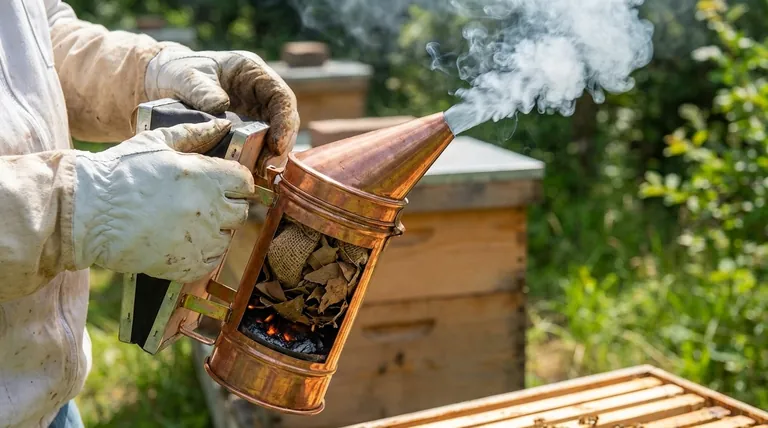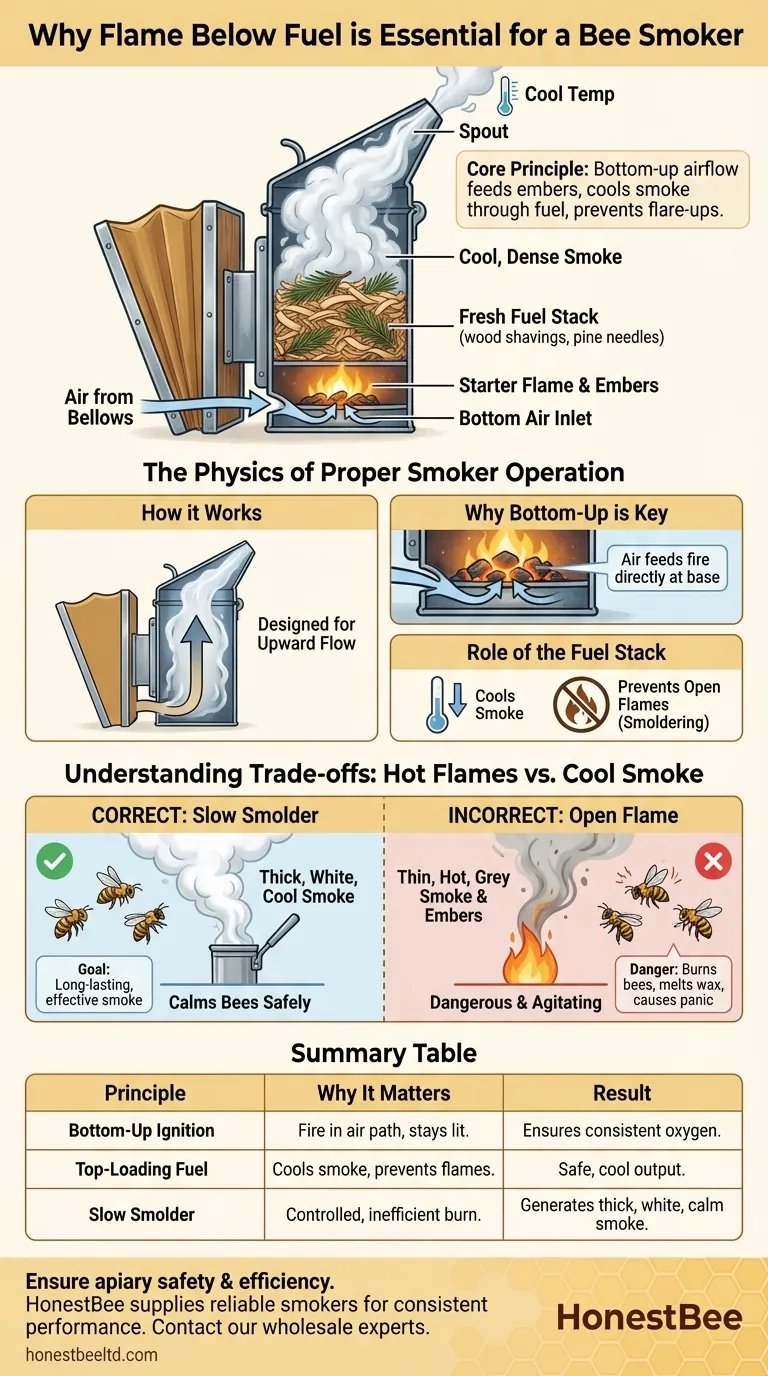In a bee smoker, placing the flame below the fuel is the essential first step to creating the correct type of smoke. This method works with the smoker's design, which introduces air from the bottom. By igniting the base and layering fresh fuel on top, you create a slow, smoldering burn that produces the cool, dense smoke required for safely managing bees.
The core principle is simple: A smoker is engineered for bottom-up airflow. Placing the fire at the bottom allows the bellows to feed the embers and push the resulting smoke up through the fuel stack, cooling it and preventing dangerous flare-ups.

The Physics of Proper Smoker Operation
To understand why this method is non-negotiable, you must first understand how the tool is designed to function. A bee smoker is not a miniature flamethrower; it is a specialized device for generating cool smoke.
How a Smoker is Designed
Every bee smoker consists of a fire chamber and attached bellows. When you pump the bellows, air is forced into the very bottom of the fire chamber. This incoming oxygen is the lifeblood of your fire.
The smoke and heat naturally want to rise and exit through the spout at the top. The entire system is built around this one-way, bottom-to-top path.
Why Bottom-Up Ignition is Key
Placing your initial flame at the bottom of the chamber puts the fire directly in the path of the incoming air from the bellows. This ensures the embers get the oxygen they need to stay lit.
As the fire is established, you add the bulk of your fuel on top of this small base fire. The heat and smoke are then forced to travel up through this tightly packed fuel stack.
The Role of the Fuel Stack
The layer of unburnt fuel on top serves two critical purposes. First, it cools the smoke. As the hot air passes through the material, it transfers much of its heat, ensuring what exits the spout is gentle and won't harm the bees.
Second, it prevents open flames. By smothering the initial fire, the fuel stack encourages a slow smolder rather than a hot, open burn. This smoldering action is what produces the ideal thick, white, and cool smoke.
Understanding the Trade-offs: Hot Flames vs. Cool Smoke
Failing to follow this principle doesn't just make the smoker less effective; it makes it dangerous for your bees and your hive. The goal is calmness, not chaos.
The Danger of an Open Flame
An improperly lit smoker—where the flame is on top or not properly smothered—can shoot hot embers or even open flames out of the spout.
This excessive heat can burn the bees' delicate wings, agitate the colony instead of calming it, and potentially even melt the beeswax in the hive.
The Goal: A Slow, Controlled Smolder
Your objective is to create a small, hot bed of embers at the very bottom that slowly consumes the fuel packed above it.
This process is inefficient for generating heat but extremely efficient for generating smoke. The signature of a well-lit and well-packed smoker is that it can produce smoke for a long time without needing constant attention.
The Signature of Success: Thick, White Smoke
When you see cool, dense, and white smoke puffing from your smoker, you know you have succeeded. This type of smoke effectively masks the bees' alarm pheromones without causing them heat-related stress.
Thin, bluish, or grey smoke is often a sign that the fire is too hot and burning too cleanly, which is the opposite of your goal.
Making the Right Choice for Your Goal
Correctly lighting your smoker is a foundational skill in beekeeping. It directly impacts the safety of your bees and your ability to work the hive effectively.
- If your primary focus is bee safety: Always layer fresh fuel on top of your starter flame to smother it. This is the single most important step to prevent shooting hot flames or embers into the hive.
- If your primary focus is long-lasting smoke: Lighting from the bottom ensures the entire fuel load is consumed slowly and evenly from the bottom up, giving you more working time per pack.
- If your primary focus is a calm colony: A bottom-lit, top-loaded smoker produces the cool, white smoke that effectively interrupts bee communication without causing panic or aggression.
Mastering this fundamental principle transforms the smoker from a crude tool into a precise instrument for responsible bee management.
Summary Table:
| Principle | Why It Matters | Result |
|---|---|---|
| Bottom-Up Ignition | Fire is placed in the path of incoming air from the bellows. | Ensures embers stay lit and receive oxygen. |
| Top-Loading Fuel | Unburnt fuel is layered on top of the initial flame. | Cools the smoke and prevents dangerous open flames. |
| Slow Smolder | Creates a controlled, inefficient burn ideal for smoke production. | Generates thick, white, cool smoke that calms bees safely. |
Ensure your apiary operates with the highest standards of bee safety and efficiency. A properly functioning smoker is fundamental to effective hive management. HONESTBEE supplies commercial apiaries and beekeeping equipment distributors with the reliable, high-quality smokers and fuel needed for consistent performance. Let us equip you for success. Contact our wholesale experts today to discuss your equipment needs.
Visual Guide

Related Products
- Premium Traditional Copper Bee Smoker with Bellows
- Economy Galvanized Beekeeping Honey Bee Smoker for Wholesale
- Stainless Steel Honey Bee Smoker Hive and Honeycomb Smoker for Beekeeping
- European Stainless Steel Bee Smoker for Honey Bee Hive
- Professional Bee Smoker with Elongated Spout and Durable Bellows for Beekeeping
People Also Ask
- What are the main components of a bee smoker? A Guide to Safe and Effective Hive Management
- How does water mist work as an alternative to smoke in beehives? A Guide to Safe & Effective Use
- What is the primary purpose of using smoke in beekeeping? Calm Bees for Safer Hive Management
- What are the benefits of using smoke properly in beekeeping? Achieve Calm, Safe Hive Inspections
- What are some alternatives to using smoke in beekeeping? A Guide to Gentle Hive Management



















